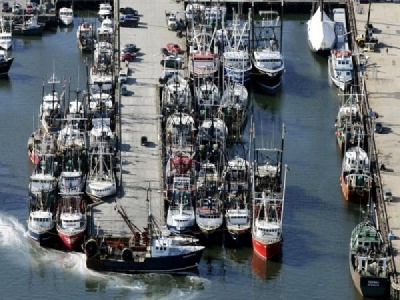
Posted on August 7, 2017
By Don Cuddy, SouthCoastTODAY
When the Seastreak ferry recently broke down, it had to tie up at the State Pier for repairs. This in turn displaced the Voyager, a 130-foot fishing vessel, which had to move to Leonard’s Wharf, where boats are already moored five-deep.
“We need updated infrastructure. When you have a 130-foot boat tied to a pier designed for 70-80 foot boats your infrastructure isn’t going to last long,” Ed Anthes-Washburn, the affable executive director of the Harbor Development Commission, told me as we toured the working waterfront in a HDC launch last week. “We also need to activate the rest of our waterfront.”
And there in a nutshell you have the core challenges facing the HDC, the city and all waterfront stakeholders.
While the demand for dockage remains huge, there is simply not enough wharf space available, even as large swaths of the New Bedford-Fairhaven waterfront remain deserted and unusable because the water is shoal.
Water depth is problematic all around the harbor. In the ship channel the depth was improved by the state two years ago from 24.5 feet to 28.5 feet at low water. This dredging operation helped to boost the volume of cargo handled by the port and encouraged the Steamship Authority to set up its maintenance facility on the Fairhaven side. But the channel depth still remains a couple of feet above the desired goal. In fact, the federal channel has not been dredged to 30 feet in more than 50 years.
“Things like oil at the Sprague terminal and the steel being exported are heavy and dense and they use the full depth. And the pilots require a 10 percent under-keel clearance,” Ed reported. “We need to get down to 30 feet to expand our opportunities for more cargo, including offshore wind.”
Without a 30-foot ship channel, the port is losing cargo while the lack of cargo weakens the argument to obtain the funds needed for more dredging. It’s a vicious circle.
Dredging the main channel would require about $75 million in federal funds, with the local contribution coming in the form of a CAD (confined aquatic disposal) cel into which the dredged material could be placed.
Expanding private berthing space represents an even greater economic opportunity for the port, according to Ed. “We have more boats coming here than ever. We have marine contractors coming in, tug operators coming in and the fishing fleet has grown in the last seven years as a result of consolidation,” he said.
Smaller ports are losing their waterfront infrastructure while New Bedford and Fairhaven remain fully-serviced ports. North of the bridge you now see barges used as floating docks at several shore-side businesses that cannot tie their vessels to the bulkhead. “Opening up the north side of Pope’s Island, for instance, would provide an incredible benefit,” Ed said.
The HDC is pursuing every avenue to find the money for dredging. There is a $35 million earmark in the 2014 environmental bond bill that needs to be appropriated into a capital plan by the governor. “We were in the same line item as Boston for dredging and Boston got their money. We need to somehow get on Boston’s radar,” Ed said.
It remains hugely frustrating that no one at the state level seems to recognize just how important this port is, economically, not only to the area but to the entire Commonwealth. We land 10 percent of the total value of fish in the United States here. In 2015, 140 million pounds of seafood was caught, landed and processed here while an additional 250 million pounds from around the world were also processed here. That’s mind-boggling.
Total economic activity within the port amounts to $9.8 billion annually and, as of 2015, supported 36,578 jobs, according to an economic impact study commissioned by the HDC and released in September 2016.
With the Baker administration so eager to develop offshore wind and the considerable investment the state has already made in building the Marine Commerce Terminal to facilitate that, dredging the harbor should really be getting a lot more attention on Beacon Hill and from our legislative delegation in particular.
With Eversource moving to the industrial park, the HDC is formulating a redevelopment plan, with Sprague’s participation, for that prime waterfront location, possibly including an offloading facility that would allow people to observe the fishing industry at work. This is one of many laudable ideas to stimulate economic development within the city and harbor, but until and unless the water depth is improved, they will remain as such.
Source: SouthCoastTODAY





